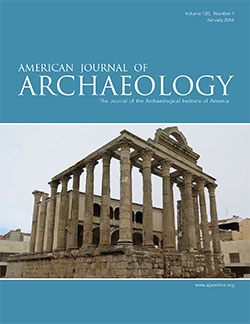AJA Open Access
BY-NCJanuary 2016 (120.1)
Book Review
Making Textiles in Pre-Roman and Roman Times: People, Places, Identities
Edited by Margarita Gleba and Judit Pásztókai-Szeőke
Reviewed by Agnete Wisti Lassen
The study of textiles has received a tremendous boost in the fields of archaeology and ancient history in recent years. This is, in part, thanks to the Danish National Research Foundation’s Center for Textile Research in Copenhagen (2005–2016) and affiliated international collaborations and projects, such as Clothing and Identities: New Perspectives on Textiles in the Roman Empire, which has highlighted the prominent role played by textiles in ancient economies. These projects have systematized research questions in a very diverse field of study that was never unified by region, period, or methodology, but rather fragmented into various disciplinary divisions. One of the great achievements has been pulling these diverse fields together through overarching research questions and a strong emphasis on combining archaeological and textual sources. Part of these efforts has been a series devoted to textiles studies, the Ancient Textiles Series. The volume reviewed here, edited by Gleba and Pásztókai-Szeőke, is the 13th in the series. The volume originated in a 2009 workshop “Work and Identity: The Agents of Textile Production and Exchange in the Roman World,” held under the aegis of the Clothing and Identities project (2008–2010). In addition to a preface by Gleba, the volume contains 13 chapters and an introduction by Wild. The volume has a general index and individual bibliographies, and it is well illustrated, with five overview maps showing most of the relevant sites (locations mentioned in chs. 4, 5, and 7 are unfortunately not included), as well as specific maps, drawings, photographs, graphs, and tables in the individual chapters.
While it is overall highly rewarding that the volume contains articles from very diverse fields, each author has retained the—sometimes highly—specialized terminology of his or her scholarly tradition. This makes the volume less easily accessible to nonspecialists. That said, the volume offers many interesting insights into the manufacture, trade, and identities involved in pre-Roman and Roman textiles, and it will be useful to any scholar and student interested in ancient economy.
The nature of the available source material makes it difficult to approach all aspects of Roman textile production evenly, but, in particular, three more limited issues can be traced across the chapters and across types of evidence: trade and demand, the fullers/felters and their work, and the gender of the craftspersons involved in the various steps of textile production.
The first three chapters, by Gleba, Lipkin, and Grömer, explore the developments of textile production in pre-Roman Italy. On the basis of animal bones, tools, and pictorial representations, Gleba (ch. 1) shows how textile production in Italy intensified and a specialized workshop mode of manufacture developed in the late seventh century B.C.E. alongside a more traditional household-based one. Lipkin (ch. 2) relates textile tools in burials with age and social rank in pre-Roman central Italy and finds that these objects were just as much—and sometimes exclusively—indicators of status rather than actual tools used by the deceased. In the richly illustrated chapter 3, Grömer deals with textiles of Iron Age Austria, which fortuitously has good conditions for preservation of archaeological textiles, mostly from Hallstatt and Dürrnberg. She provides a full description of the types of evidence and addresses both the organization and context of production as well as social status and gender.
Gostenčnik (ch. 4) follows Austria and the north during the Roman periods through a careful analysis of textile tools from various archaeological sites. Gostenčnik also mentions lead tesserae (small lead tags), which in abbreviated form list such things as names, services, products, and prices. These tags are the topic of chapter 5, by Radman-Livaja, which includes a detailed treatment of their research history and uses and focuses on the personal names on tags from first- to second-century C.E. Siscia in present-day Croatia. They can usually be linked to specific trades or commercial activities, often involving textiles, and Radman-Livaja concludes that the names on the tags referred to clients who had wool—but more commonly woven—textiles fulled, dyed, and/or tailored in professional establishments. This article dovetails nicely into chapters 12 (Flohr) and 13 (Dickman), which use archaeology, iconography, and to a degree also epigraphy, to approach the workspaces and identity of the (primarily male) fullers/felters. These three articles together provide important insights into many post-production treatments, such as fulling, dyeing, tayloring, cleaning, and mending, and the spaces and structures of these services. While Flohr and Dickman do not focus on the gendered nature of the craft, female gender is discussed by Larsson Lovén and Gällnö in chapters 6 and 10 in relation to spinning and other types of textile work.
The demand for luxury textiles by an urban elite is mentioned in several articles as a driving factor for both production and trade, but some authors also highlight the importance of textiles of average—though still very lucrative—quality in the Roman textile economy. Liu (ch. 7) suggests that southern Gaul and northern Italy may have been supply centers of nonluxury textiles for nonlocal trade. She emphasizes the general population of Rome and the army as consumers for this production. Droß-Krüpe (ch. 9) likewise points to the significance of average- quality exports and imports in the Red Sea trade. Both Droß-Krüpe and Vivero (ch. 8) use the important Periplus of the Erythraean Sea as a geographic source to map the regional mobility of textiles and individuals.
Although the authors do not always speak the same scholarly vernacular, the editors must be commended for bringing together specialists from diverse fields to address this important topic. As a collection, the articles sometimes appear a little disconnected and of varying quality, but the volume successfully shows how the integration of various types of sources can be used to shed light on the complexities of this ancient craft.
Agnete Wisti Lassen
Yale Babylonian Collection
Yale University
agnete.lassen@yale.edu
